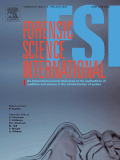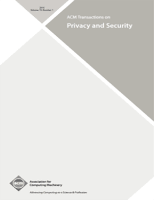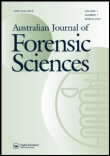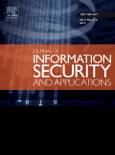
International Journal of Electronic Security and Digital Forensics
Scope & Guideline
Advancing knowledge in cybersecurity and digital forensics.
Introduction
Aims and Scopes
- Cybersecurity Innovations:
Focuses on advancements in cybersecurity technologies and methodologies, including machine learning, deep learning, and cryptographic techniques to enhance security measures against cyber threats. - Digital Forensics Techniques:
Explores methods and tools for digital forensic investigations, including mobile forensics, cloud forensics, and techniques for recovering and analyzing digital evidence. - Legal and Regulatory Frameworks:
Examines the evolving legal landscape surrounding digital security and forensics, addressing issues such as cybercrime legislation, data privacy, and the legal implications of emerging technologies. - Intrusion Detection and Prevention:
Investigates systems and protocols designed to detect and prevent unauthorized access or attacks on digital infrastructures, utilizing advanced detection algorithms and frameworks. - Emerging Technologies and Their Impact:
Analyzes the impact of emerging technologies such as IoT, blockchain, and AI on digital security and forensics, providing insights into their application and associated challenges.
Trending and Emerging
- Machine Learning and AI in Cybersecurity:
An increasing number of publications are exploring the application of machine learning and AI techniques for enhancing cybersecurity measures and automating forensic processes. - Cloud Computing and Forensics:
The intersection of cloud computing and digital forensics is gaining traction, with research focusing on the challenges and methodologies for conducting forensic investigations in cloud environments. - IoT Security Challenges:
As the Internet of Things continues to expand, there is a growing emphasis on the security challenges associated with IoT devices, including novel encryption methods and intrusion detection systems. - Data Privacy and Protection Laws:
Research is increasingly addressing the complexities of data privacy and protection laws, particularly in light of new regulations and their implications for digital security practices. - Adversarial Machine Learning:
Emerging studies on adversarial machine learning are focusing on threats to AI systems and developing strategies to enhance the robustness of security measures against such attacks.
Declining or Waning
- Traditional Forensic Methodologies:
Research focusing on conventional digital forensic methods is becoming less frequent, possibly due to the rapid development of new technologies and methodologies that offer more efficient and effective solutions. - General Cybercrime Studies:
Broad studies on cybercrime without a specific focus on technology or methodology are declining, as researchers are increasingly targeting niche areas or specific types of cyber threats. - Legal Frameworks in Specific Jurisdictions:
While legal considerations remain important, the focus on legal frameworks pertaining to specific countries or jurisdictions is waning in favor of more global or comparative legal analyses.
Similar Journals

Cybersecurity
Leading the Charge in Cybersecurity ResearchCybersecurity, published by SpringerNature, serves as a pivotal platform in the realms of Artificial Intelligence, Information Systems, Software, and Computer Networks and Communications. With an impressive Impact Factor and an Open Access model initiated in 2018, this journal facilitates widespread dissemination of innovative research findings to a global audience. Based in the United Kingdom, Cybersecurity aims to advance knowledge and application in security innovations, risk management, and system resilience against cyber threats. The journal's current standing is prominently reflected in its Q1 and Q2 ratings across various computer science categories, indicating its reputable contribution to the academic community. By continuously publishing cutting-edge research, Cybersecurity plays a crucial role in informing policy decisions, advancing technology, and enhancing the collective understanding of cyber resilience, making it an essential resource for researchers, professionals, and students alike.

Forensic Science International
Unveiling Truth through Rigorous ScholarshipForensic Science International is a premier journal published by Elsevier Ireland Ltd, dedicated to advancing the field of forensic science through interdisciplinary research and scholarship. Since its inception in 1978, this esteemed journal has provided a platform for vital research, receiving recognition in the Q1 category for both Law and Pathology and Forensic Medicine as of 2023, underscoring its significant impact in these domains. It currently ranks 54th out of 1025 journals in Social Sciences - Law and 51st out of 208 in Medicine - Pathology and Forensic Medicine, placing it in the top echelons of academic journals according to Scopus metrics. Forensic Science International transitioned to Open Access in 2019, ensuring that critical findings are widely available to the global research community and enhancing collaboration among forensic professionals. With a forward-looking scope that evolves to meet the challenges and innovations of forensic science, this journal remains a pivotal resource for researchers, practitioners, and students who are committed to the continued advancement of forensic science and its applications in legal contexts.

ACM Transactions on Privacy and Security
Elevating Standards in Privacy and Security Research.ACM Transactions on Privacy and Security, published by the Association for Computing Machinery, is a prestigious journal dedicated to the field of computer science, with a particular focus on privacy and security in modern computing environments. Since its inception in 2016, this journal has become a vital resource for researchers, professionals, and students alike, addressing the increasing concerns surrounding data protection and risk management. With an impressive impact factor and recognition as a Q1 journal in both Computer Science (Miscellaneous) and Safety, Risk, Reliability and Quality, it ranks among the top publications in its field, positioned at the 73rd percentile in General Computer Science and the 71st percentile in Engineering. The journal’s Open Access options enhance accessibility to cutting-edge research, fostering collaboration and innovation in the rapidly evolving landscape of privacy and security. Readers can expect high-quality peer-reviewed articles that contribute significantly to both theoretical and practical advancements in technology and data security.

Australian Journal of Forensic Sciences
Unveiling Truths Through Comprehensive Forensic StudiesThe Australian Journal of Forensic Sciences, published by Taylor & Francis Ltd, stands as a pivotal resource in the field of forensic medicine and pathology. With an ISSN of 0045-0618 and an E-ISSN of 1834-562X, this esteemed journal has been at the forefront of forensic research since its inception in 1968. Currently classified in the Q2 category for the year 2023 within its domain, it ranks 92nd out of 208 journals, placing it within the 55th percentile in Scopus rankings. The journal's scope encompasses a diverse range of topics critical to the advancement of forensic sciences, making it an essential platform for researchers, professionals, and students seeking to stay abreast of the latest developments and methodologies in the field. Although not an open-access publication, the journal serves as a crucial conduit for disseminating high-quality research, contributing significantly to the ongoing evolution of forensic practice and knowledge.

Ad Hoc & Sensor Wireless Networks
Pioneering discoveries in wireless technology and engineering.Ad Hoc & Sensor Wireless Networks, an esteemed journal published by OLD CITY PUBLISHING INC, provides a dedicated platform for the dissemination of pioneering research in the realms of computer science, electrical and electronic engineering, and instrumentation. With an ISSN of 1551-9899 and an E-ISSN of 1552-0633, this journal has established itself as a crucial resource for scholars and practitioners alike, actively contributing to the advancements in ad hoc networks and wireless sensor technologies. It holds a commendable position within the third quartile in its respective fields, with Scopus rankings reflecting its relevance in the academic community. As a publicly accessible source of valuable insights, the journal aims to inspire innovation and facilitate progress across various disciplines. Situated in Philadelphia, PA, and converging its efforts from 2005 to 2024, Ad Hoc & Sensor Wireless Networks continues to be a beacon of research excellence, impacting both theoretical and practical domains in technology.

Journal of Computer Virology and Hacking Techniques
Exploring the Frontiers of Cybersecurity and Digital DefenseWelcome to the Journal of Computer Virology and Hacking Techniques, a prestigious academic publication dedicated to the evolving fields of cybersecurity and digital threats. Published by Springer France, this open-access journal has been at the forefront of disseminating high-quality research since its inception in 2014. With an increasing impact in areas such as computational theory, hardware architecture, and software security, the journal holds a significant position, classified in the Q2 and Q3 quartiles across several categories in 2023. The journal aims to provide a platform for researchers, professionals, and students to explore the latest advances in combatting cyber vulnerabilities and understanding hacking techniques. In alignment with its open-access policy, the journal ensures that knowledge is readily available to a global audience, reinforcing its mission to enhance the scholarly discourse surrounding computer virality while adhering to rigorous academic standards.

Journal of Information Security and Applications
Empowering Innovations in Security ApplicationsJournal of Information Security and Applications, published by ELSEVIER, is a premier outlet for cutting-edge research in the field of information security and applications. With a dedicated ISSN of 2214-2126 and an E-ISSN of 2214-2134, this journal ranks impressively in the top quartile (Q1) across multiple categories as of 2023, including Computer Networks and Communications, Safety, Risk, Reliability and Quality, and Software. The journal’s notable Scopus rankings further reflect its impact, holding positions within the top 15% in several engineering and computer science areas. Spanning a converged period from 2013 to 2024, the journal aims to disseminate high-quality research findings, facilitating a vibrant platform for scholars, practitioners, and students to engage with contemporary challenges in information security. Although not an open-access journal, the knowledge shared within its pages is indispensable for those dedicated to advancing the technological and theoretical underpinnings of security measures in various applications.

COMPUTERS & ELECTRICAL ENGINEERING
Empowering Innovation in Technology and Engineering.COMPUTERS & ELECTRICAL ENGINEERING is a premier academic journal published by PERGAMON-ELSEVIER SCIENCE LTD, based in the United Kingdom. Established in 1973, the journal has consistently contributed to the fields of Computer Science, Control and Systems Engineering, and Electrical and Electronic Engineering. With an impressive impact factor and ranked in the top quartile (Q1) across these domains, it is recognized as a pivotal resource for researchers, practitioners, and students alike. The journal aims to disseminate high-quality research articles, reviews, and technical notes, with the goal of advancing understanding and fostering innovation within and beyond its scope. Researchers can enjoy unparalleled access to cutting-edge findings and technological advancements through contributions that span both theoretical frameworks and practical applications, making it an essential platform for anyone dedicated to exploring the intersections of these dynamic fields.

Digital Communications and Networks
Transforming ideas into impactful digital solutions.Digital Communications and Networks, published by KEAI PUBLISHING LTD, stands at the forefront of research in the rapidly evolving fields of communication, computer networks, and hardware architecture. Since its inception in 2015, this open access journal has been committed to disseminating high-quality, peer-reviewed articles that contribute to technological advancements and academic discourse in these critical domains. With an impressive Impact Factor and achieving Q1 Quartile rankings in its relevant categories for 2023, it has established itself as a vital resource for researchers, professionals, and students aiming to stay ahead in a competitive landscape. The journal's robust standing is reflected in its notable Scopus rankings, underscoring its influence in Computer Science and related fields. As we look toward the future, the journal continues to invite innovative research that shapes the digital communication landscape until 2024 and beyond.

Journal of Transportation Security
Exploring the Nexus of Security and MobilityWelcome to the Journal of Transportation Security, a premier academic publication dedicated to the interdisciplinary study of security issues pertaining to transportation systems across the globe. Since its inception in 2008 and under the esteemed publication of SPRINGER, this journal serves as a vital platform for dissemination of cutting-edge research that influences policy, safety standards, and operational practices. With an impressive Q2 ranking in Law, Political Science, and Sociology, alongside Q3 ratings in Management Science and Transportation, the journal caters to a diverse audience of researchers, practitioners, and students eager to explore the intricate relationships between transportation and security. By promoting scholarly discussion and offering a wealth of insight into current challenges and innovations in the field, the Journal of Transportation Security remains an invaluable resource for anyone committed to enhancing safety and security in transportation. Engage with our robust archive for unparalleled research contributions up to 2024 and join us in shaping the future of transportation security.